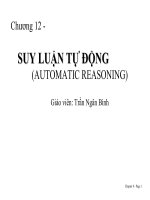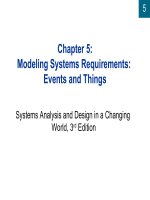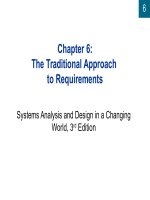slike bài giảng ứng dụng xây dựng hệ thống thông tin chương 8 evaluating alternatives for requirements, environment, and implementation
Bạn đang xem bản rút gọn của tài liệu. Xem và tải ngay bản đầy đủ của tài liệu tại đây (598.95 KB, 31 trang )
8
Chapter 8:
Evaluating Alternatives for
Requirements, Environment,
and Implementation
Systems Analysis and Design in a Changing
World, 3
rd
Edition
8
Systems Analysis and Design in a Changing World,
3rd Edition
2
Learning Objectives
Prioritize the system requirements based on the
desired scope and level of automation for the new
system
Describe the strategic decisions that integrate the
application deployment environment and the
design approach for the new system
Determine alternative approaches for system
development
8
Systems Analysis and Design in a Changing World,
3rd Edition
3
Learning Objectives (continued)
Evaluate and select a development approach
based on the needs and resources of the
organization
Describe key elements of a request for proposal
and evaluate vendors’ proposals for outsourced
alternatives
Develop a professional presentation of findings to
management
8
Systems Analysis and Design in a Changing World,
3rd Edition
4
Overview
Chapter explains last three activities of analysis
Prioritize systems requirements
Generate and evaluate alternatives
Review recommendation with management
Refocus project direction
Transition from discovery and analysis to
solutions and design
Set direction for design and implementation of
solution system
8
Systems Analysis and Design in a Changing World,
3rd Edition
5
Project Management Perspective
Project manager and senior technical members of
project team work together
Eight areas of project management
Human resources
Procurement
Communications
Risk
Scope
Time
Cost
Quality
8
Systems Analysis and Design in a Changing World,
3rd Edition
6
Deciding on Scope and Level of Automation
Scope determines which business functions will
be included in system
Level of automation is how much computer
support exists for functions included in level
Scope creep
Requests for addition of system functions after
requirements defined and decision has been made
Users typically request more business functions
than budget allows
8
Systems Analysis and Design in a Changing World,
3rd Edition
7
Determining the Level of Automation
Low level
Simple computer records keeping
Medium level
Midrange point which combines features from low
and high alternatives
High level
System takes over processing of business function
8
Systems Analysis and Design in a Changing World,
3rd Edition
8
Selecting Alternatives
Entire group of alternatives is evaluated together
to provide “big picture” view of proposed system
Key criteria that are used:
Strategic plan
Economic feasibility
Schedule and resource feasibility
Technological feasibility
Operational, organizational, and cultural feasibility
8
Systems Analysis and Design in a Changing World,
3rd Edition
9
Defining the Application
Deployment Environment
Configuration of:
Computer hardware
System software
Networks
Development Tools
Existing environment generally considered and
compared with proposed environment
8
Systems Analysis and Design in a Changing World,
3rd Edition
10
Hardware, System Software, and Networks
Older batch-mode applications on centralized
mainframe
Stand-alone applications on mini- and personal
computers
On-line interactive applications
Distributed applications
Web-based applications
8
Systems Analysis and Design in a Changing World,
3rd Edition
11
Deployment Environment Characteristics
Compatibility with system requirements
Compatibility among hardware and system
software
Required interfaces to external systems
Conformity with IT strategic plan and architecture
plans
Cost and schedule
8
Systems Analysis and Design in a Changing World,
3rd Edition
12
Development Tools
Programming languages, CASE tools, software
used to develop application software
Java and Visual Studio.NET are examples
Application deployment environment decisions
limit development tool choices
Operating system environment
Database management system (DBMS)
Distributed software standard
8
Systems Analysis and Design in a Changing World,
3rd Edition
13
Existing Processing Environment at RMO
8
Systems Analysis and Design in a Changing World,
3rd Edition
14
Processing Environment Alternatives
8
Systems Analysis and Design in a Changing World,
3rd Edition
15
Strategic Directions for RMO
8
Systems Analysis and Design in a Changing World,
3rd Edition
16
Choosing Implementation Alternatives
Variations on obtaining system
Facilities management outsource all IS support
Packaged software, Turnkey system, ERP system
Custom-built software systems
In-house development
Selection dimensions
Buy vs. build
In-house vs. outsource
8
Systems Analysis and Design in a Changing World,
3rd Edition
17
Implementation Alternatives
8
Systems Analysis and Design in a Changing World,
3rd Edition
18
Selecting an Implementation Alternative
Identifying Criteria for Selection
Comparisons can be difficult
Different proposed systems have strengths in
different areas
Three major areas to consider
General requirements
Technical requirements
Functional requirements
8
Systems Analysis and Design in a Changing World,
3rd Edition
19
Partial Matrix of General Requirements
8
Systems Analysis and Design in a Changing World,
3rd Edition
20
Partial Matrix of Functional Requirements
8
Systems Analysis and Design in a Changing World,
3rd Edition
21
Partial Matrix of Technical Requirements
8
Systems Analysis and Design in a Changing World,
3rd Edition
22
Making the Selection
First, rate each alternative with raw score
Weighted scores are then tabulated and
compared to make a choice
RMO decided on in-house development for most
CSS development to keep expertise within RMO
RMO wants to hire some new technical
specialists
RMO feasibility review showed no serious
problems – once specialists are added
8
Systems Analysis and Design in a Changing World,
3rd Edition
23
Contracting with Vendors
Generating Request for Proposal (RFP)
Formal document sent to vendors if in-house
development not selected
States requirements and solicits proposed
solutions
Considered a competitive contract offer
Bid on supplying hardware, software, and/or
support services
8
Systems Analysis and Design in a Changing World,
3rd Edition
24
I. Introduction and Background
II. Overview of Need
III. Description of Technical Requirements
IV. Description of Functional Requirements
Sample RFP Table of Contents
8
Systems Analysis and Design in a Changing World,
3rd Edition
25
V. Description of General Requirements
VI. Requested Provider and Project Information
VII. Details for Submitting Proposal
IV. Evaluation Criteria and Process
Sample RFP Table of Contents (continued)









